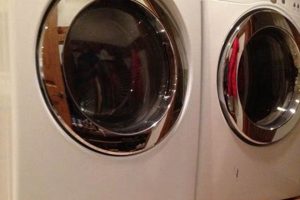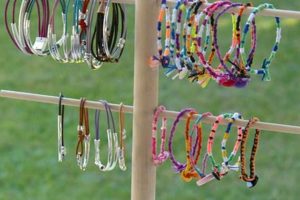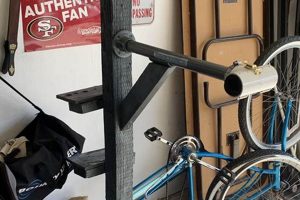The construction of a self-made support structure for aquatic enclosures represents a multifaceted endeavor involving elements of design, engineering, and craftsmanship. Such projects typically entail the selection of appropriate materials, precise measurements, and secure assembly techniques to ensure the safe and stable support of a water-filled tank. An example would be building a wooden frame capable of bearing the significant weight of a fully established aquarium.
Providing a foundation for aquatic habitats offers numerous advantages. Constructing such a structure provides a cost-effective alternative to commercially available options. This also allows for customization to precisely fit spatial constraints and aesthetic preferences. Historically, individuals have created personalized supports to meet specific needs, demonstrating ingenuity and resourcefulness in aquatic keeping.
The subsequent sections will delve into critical aspects of this undertaking, encompassing material selection, structural design considerations, and essential safety protocols for successful fabrication.
Tips for Constructing a Stable Aquatic Habitat Support
The creation of a durable and safe support for an aquatic enclosure requires careful planning and execution. The following guidelines are designed to assist in ensuring a successful build.
Tip 1: Material Selection: Choose materials with sufficient load-bearing capacity and resistance to moisture damage. Solid wood, such as oak or maple, or steel are preferable. Avoid particleboard or MDF in areas prone to water exposure.
Tip 2: Precise Measurement: Accurate measurements are crucial for structural integrity. Verify dimensions of the aquarium and plan for adequate clearance around the tank for maintenance. Double-check all measurements prior to cutting materials.
Tip 3: Robust Joinery: Employ strong joinery techniques such as mortise and tenon, dovetails, or pocket screws with wood glue to ensure stability. Avoid relying solely on nails or screws, as these may loosen over time.
Tip 4: Leveling is Essential: Ensure the base is perfectly level to distribute weight evenly. Use shims to correct any unevenness in the flooring. A level base prevents undue stress on the aquarium glass.
Tip 5: Reinforcement Strategies: Incorporate bracing and reinforcement, particularly at corners and along the span of the support, to prevent bowing or sagging under the tank’s weight. Triangular bracing is a common and effective solution.
Tip 6: Moisture Protection: Apply a sealant or waterproof coating to all wood surfaces to protect against water damage and prevent warping. Consider using marine-grade varnish for maximum protection.
Tip 7: Weight Distribution Planning: Account for the weight of the aquarium, substrate, decorations, and water. Overestimate the total weight to provide a safety margin. Proper weight distribution will ensure the longevity of the setup.
Adhering to these principles will result in a secure and aesthetically pleasing foundation for the aquatic display. Proper construction is paramount to prevent potential failures and ensure the safety of both the aquarium and its surroundings.
The next section will address common pitfalls to avoid during construction.
1. Structural Integrity
Structural integrity constitutes a foundational requirement in the domain of self-constructed aquatic enclosure supports. The capacity of the support to withstand the substantial weight of a water-filled aquarium is directly dependent on its inherent structural robustness. Failure to adequately address this aspect can result in catastrophic consequences, including collapse and potential damage to property.
- Material Selection and Load-Bearing Capacity
The selection of materials directly impacts the support’s ability to bear weight. Solid wood, steel, or reinforced composites are typically favored for their inherent strength. Consideration must be given to the specific load-bearing capacity of the chosen material, factoring in the dimensions of the aquarium and the density of water. For instance, a stand constructed from softwood without adequate reinforcement is unlikely to withstand the weight of a large aquarium.
- Joinery Techniques and Connection Strength
The methods used to join structural components are critical to overall stability. Robust joinery techniques, such as mortise and tenon, dovetail joints, or secure bolting, ensure that the structure remains cohesive under stress. Weak or poorly executed joints represent a potential point of failure. Consider a scenario where a stand is assembled solely with screws; the screws may shear or loosen over time, compromising the structure’s integrity.
- Bracing and Reinforcement Strategies
Incorporating bracing elements enhances structural integrity by distributing weight and resisting deformation. Diagonal bracing, cross-bracing, or gussets at corners provide additional support, preventing racking or swaying. For example, adding a central vertical support to a long aquarium stand reduces the risk of bowing in the center.
- Stability and Leveling Considerations
A stable and level foundation is paramount for even weight distribution. Uneven weight distribution can create stress points, potentially leading to structural failure. Shimming or leveling feet should be used to compensate for irregularities in the floor. Neglecting to level the base can result in undue stress on the tank’s glass, increasing the risk of leaks or breakage.
Collectively, these facets of structural integrity underscore its indispensable role in the creation of a safe and durable support for aquatic enclosures. Thorough consideration of these factors during the design and construction phases is essential to mitigate risks and ensure the long-term stability of the aquarium setup. Ignoring any of these aspects significantly elevates the potential for structural compromise and subsequent failure.
2. Material Selection
Material selection constitutes a critical determinant in the success and longevity of an enclosure support. The inherent properties of the chosen material directly influence the structure’s ability to withstand the sustained weight, moisture exposure, and potential impacts associated with containing an aquatic environment. Inappropriate material selection can lead to structural instability, premature degradation, and ultimately, failure of the support system. For example, utilizing untreated softwood in a high-humidity environment will likely result in warping, rot, and eventual structural compromise. Therefore, thoughtful consideration of material characteristics is paramount.
The connection between material selection and stability is a cause-and-effect relationship. Selecting materials with insufficient load-bearing capacity, such as thin plywood or plastic, introduces a significant risk of collapse under the weight of a filled aquarium. Conversely, opting for robust materials like hardwoods (oak, maple) or steel provides a substantial safety margin. Furthermore, resistance to moisture is crucial, as constant exposure to water can degrade certain materials over time. Applying a sealant or choosing naturally water-resistant materials minimizes the risk of rot and structural weakening. Consider the practical example of choosing a steel frame over a wooden one for large tanks; the steel offers superior strength and resistance to long-term creep under load.
In summary, material selection is not merely a cosmetic decision but rather a fundamental engineering consideration. The integrity of the self-constructed aquatic enclosure support hinges on the careful evaluation of material properties, ensuring both structural stability and resistance to environmental factors. Challenges in this process include balancing cost considerations with performance requirements and accurately assessing the long-term effects of moisture exposure. The prudent application of sound material selection principles is indispensable for achieving a durable and safe aquatic display.
3. Load Calculation
In the context of self-made aquarium supports, load calculation represents a fundamental engineering practice critical to ensuring structural integrity and preventing catastrophic failure. This process involves accurately determining the total weight the structure will bear when the aquarium is filled, incorporating the weight of the tank itself, the water, substrate, decorations, and any other components housed within the aquarium. An underestimation of this load introduces a direct risk of structural compromise, potentially leading to collapse and subsequent damage to the aquarium and its surroundings. For instance, neglecting to account for the significant weight of gravel or large rock features can result in an insufficient support structure, incapable of safely bearing the intended load.
The accurate assessment of weight is vital for selecting appropriate materials and designing a support system capable of withstanding the anticipated forces. The density of water, approximately 8.34 pounds per gallon, must be factored into the calculation based on the aquarium’s volume. Material properties, such as the load-bearing capacity of wood or steel, must then be considered to ensure the chosen materials are adequate. As an example, a 100-gallon aquarium will contain roughly 834 pounds of water alone, necessitating a structure capable of supporting well over 1000 pounds when accounting for the tank, substrate, and decorations. This dictates specific dimensional and material requirements to maintain structural integrity.
Effective load calculation informs design decisions, promotes safe construction practices, and ultimately safeguards the investment in the aquatic display. Neglecting this crucial step introduces unacceptable risk. The challenges inherent in load calculation include accurately estimating the weight of all components and properly accounting for dynamic loads that may occur during maintenance or water changes. Thorough and accurate load calculation constitutes an indispensable aspect of the self-made aquarium support process, directly impacting its safety, stability, and long-term performance.
4. Joint Strength
In the context of self-constructed aquatic enclosure supports, joint strength emerges as a paramount factor directly influencing structural stability and safety. The effectiveness of the connections between structural components determines the ability of the stand to withstand the substantial weight of a water-filled aquarium. Inadequate joint strength creates a potential point of failure, increasing the risk of catastrophic collapse. For example, if the joints securing the horizontal support beams to the vertical legs are insufficiently robust, the stand may buckle under the weight, leading to a disastrous outcome.
Numerous joint types can be employed, each offering varying degrees of strength and suitability. Mortise and tenon joints, dovetail joints, and well-executed bolted connections typically provide superior strength compared to simple screw or nail assemblies. The choice of joint should align with the anticipated load and the material properties of the construction materials. For instance, a large aquarium support may benefit from steel brackets reinforcing wooden joints, ensuring resistance to shearing forces. Conversely, a smaller, lighter aquarium could potentially utilize pocket screws with appropriate wood glue, provided that the joint is properly executed and the materials are compatible.
Ultimately, ensuring adequate joint strength requires a thorough understanding of joint mechanics, material properties, and the anticipated load on the structure. Careful selection and execution of appropriate jointing techniques are indispensable for creating a safe and durable aquarium support. Ignoring joint strength introduces unacceptable risk, jeopardizing the stability of the aquatic display and potentially resulting in significant damage and loss.
5. Moisture Resistance
Moisture resistance represents a critical design consideration for any structure intended to support an aquarium. Aquatic enclosures, by their very nature, create humid environments prone to spills and leaks. Supports constructed without adequate protection against moisture degradation are susceptible to warping, rot, and subsequent structural weakening. The link between material durability and water exposure dictates the long-term stability of the stand. For instance, a support built from untreated wood, constantly exposed to water, will inevitably deteriorate, compromising its ability to bear the aquarium’s weight. This presents a direct safety hazard. The incorporation of moisture-resistant materials and appropriate sealing techniques is thus paramount to ensuring a stable and long-lasting support system.
The selection of materials and protective coatings plays a significant role in mitigating moisture-related risks. Hardwoods with inherent water resistance, such as cedar or redwood, offer a natural defense, although they may still benefit from additional protection. Alternatively, the application of marine-grade varnish or epoxy coatings provides a durable barrier against moisture penetration, regardless of the underlying material. Practical applications include sealing all exposed wood surfaces, paying particular attention to joints and edges, which are more vulnerable to water absorption. Choosing metal supports treated with rust-resistant coatings is another strategy for combating moisture damage. Careful attention to ventilation around the stand can also help to reduce humidity levels and prevent moisture buildup.
In summary, moisture resistance is an indispensable component of responsible aquarium stand design and construction. The selection of appropriate materials, the application of protective coatings, and the implementation of preventative measures are essential for ensuring the long-term stability and safety of the aquatic display. Neglecting moisture resistance introduces a significant risk of structural compromise, potentially resulting in catastrophic failure. Understanding the cause-and-effect relationship between water exposure and material degradation is fundamental to creating a durable and reliable support structure.
6. Leveling Precision
Leveling precision constitutes a non-negotiable aspect of self-made aquatic enclosure supports. Achieving a perfectly level base is essential for distributing the weight of the aquarium evenly across the entire support structure. Deviations from level introduce concentrated stress points, potentially leading to catastrophic failure. The following facets illuminate the significance of leveling precision in relation to constructed aquatic enclosure supports.
- Weight Distribution and Structural Integrity
An unlevel support concentrates the aquarium’s weight on specific points, rather than distributing it evenly across the entire structure. This uneven weight distribution introduces stress fractures within the aquarium glass or compromises the stand’s structural integrity, increasing the risk of collapse. For instance, a support that is even slightly off-level can place excessive pressure on a single corner of the tank, potentially causing the glass to crack or shatter over time. Maintaining level minimizes these risks.
- Minimizing Stress on Aquarium Glass
Aquarium glass, while strong, is susceptible to stress fractures when subjected to uneven pressure. A level base ensures that the glass experiences uniform pressure across its entire surface, minimizing the risk of stress-induced cracking or breakage. In contrast, an unlevel base can warp the glass, creating zones of high stress concentration. A practical example would be placing a ruler along the base of a full tank any gap reveals uneven pressure, even if the stand appears level.
- Impact on Joint Stability
A perfectly level base ensures all joints bear their designed load. An unlevel base transfers more weight to some joints than others, compromising the effectiveness of joinery techniques and accelerating wear and tear. Over time, overloaded joints may weaken or fail, undermining the overall structural integrity of the enclosure support. This is especially important in DIY projects relying on wooden joints. A leaning stand means certain joints bear a disproportionate share of the load.
- Long-Term Stability and Safety
Achieving leveling precision is not merely a short-term concern but a critical factor in ensuring the long-term stability and safety of the aquarium setup. A level base prevents the gradual shifting or settling of the support over time, which could exacerbate existing stress points or introduce new ones. The consequences of neglecting leveling precision extend beyond potential equipment damage to include risks to property and personal safety. A structurally unsound support has the potential for sudden and catastrophic failure.
Leveling precision, therefore, is not an optional step but an essential element in the creation of a safe and reliable support for aquatic enclosures. The principles described directly and significantly impact the stability, longevity, and safety of a homemade aquarium structure, underscoring its critical importance in the self-made construction process.
7. Design Customization
Design customization, when applied to self-constructed aquatic enclosure supports, represents a significant opportunity to tailor the structure to specific needs and aesthetic preferences. This facet goes beyond mere functionality, allowing for the creation of a support system that seamlessly integrates with the surrounding environment and meets unique requirements.
- Spatial Optimization
Custom design facilitates the optimization of space utilization. Pre-fabricated stands often adhere to standard dimensions, potentially leading to inefficient use of available area. A custom-designed support can be precisely tailored to fit within specific spatial constraints, maximizing the available room and accommodating unusual layouts. For example, a stand built to fit snugly within an alcove or under a staircase would be an instance of spatial optimization.
- Aesthetic Integration
Customization enables seamless integration with the existing decor and architectural style of the room. Selection of materials, finishes, and design elements can be tailored to complement the surrounding aesthetic. This could involve matching the wood type and stain to existing furniture or incorporating design features that echo architectural details. A stand designed to blend seamlessly into a minimalist living room would exemplify this aesthetic integration.
- Functional Enhancements
Custom design allows for the incorporation of specific functional enhancements tailored to the aquarist’s needs. This might include integrated storage for equipment and supplies, dedicated spaces for plumbing and electrical components, or ergonomic considerations for ease of maintenance. An example is a stand incorporating a built-in sump filtration system and ample storage for food, testing kits, and water treatment chemicals.
- Personalized Features
Customization provides the opportunity to incorporate personalized features reflecting individual preferences. This could include unique design elements, personalized engravings, or integrated lighting systems. A stand adorned with handcrafted details or designed to showcase specific decorative elements within the aquarium represents such a personalized feature.
In conclusion, design customization represents a powerful tool for creating aquatic enclosure supports that are not only functional but also seamlessly integrated into their intended environment. By considering spatial constraints, aesthetic preferences, functional requirements, and personalized features, aquarists can create truly unique and optimized support systems. The advantages extend beyond mere aesthetics to encompass improved functionality, space utilization, and a heightened sense of ownership and pride.
Frequently Asked Questions
The following addresses common inquiries regarding the design, construction, and safety of self-made aquatic enclosure supports.
Question 1: What is the minimum required load-bearing capacity for a self-constructed aquatic enclosure support?
The minimum required load-bearing capacity must exceed the total weight of the filled aquarium, including the tank itself, the water, substrate, decorations, and any other equipment housed within. An overestimation is advisable to provide a safety margin.
Question 2: Which materials are most suitable for constructing a durable aquatic enclosure support?
Solid hardwoods such as oak, maple, or cherry are generally recommended for wood construction. Steel offers superior strength and durability. Avoid using particleboard or MDF in areas susceptible to moisture.
Question 3: What are the key considerations for ensuring proper joint strength in a self-constructed stand?
Employ robust joinery techniques, such as mortise and tenon joints, dovetail joints, or bolted connections. Reinforce joints with metal brackets as needed. Ensure proper alignment and secure fastening.
Question 4: How can moisture damage be prevented in a wooden aquatic enclosure support?
Apply a waterproof sealant or marine-grade varnish to all exposed wood surfaces. Ensure adequate ventilation around the stand to minimize humidity. Consider using naturally water-resistant woods, such as cedar or redwood.
Question 5: Why is leveling precision crucial for aquarium stand construction?
A level base ensures even weight distribution, preventing concentrated stress points on the aquarium glass or support structure. Use shims or leveling feet to compensate for irregularities in the floor.
Question 6: What are the potential consequences of neglecting proper construction techniques for an aquarium stand?
Neglecting proper construction techniques can lead to structural failure, resulting in damage to the aquarium, water damage to the surrounding area, and potential injury.
Adherence to sound construction principles is essential for ensuring the safety and longevity of a self-made aquatic enclosure support. Prior planning and execution are crucial to mitigate potential risks.
The succeeding section will delve into troubleshooting for common construction challenges.
Conclusion
The foregoing analysis has explored the multifaceted aspects of creating a self-made aquatic enclosure support. Central themes have included structural integrity, material selection, load calculation, joint strength, moisture resistance, leveling precision, and design customization. These elements collectively contribute to the stability and safety of the completed unit. Prioritizing these considerations is paramount in ensuring the proper functioning and extended lifespan of the system.
The construction of an aquarium tank stand diy project presents a complex undertaking demanding a convergence of engineering principles, practical skills, and meticulous execution. It is incumbent upon individuals undertaking such endeavors to approach the task with diligence and a commitment to adhering to established safety protocols. The long-term success and stability of the aquatic environment are fundamentally intertwined with the quality and integrity of the support structure. Ignoring these core tenets could lead to dire consequences.







